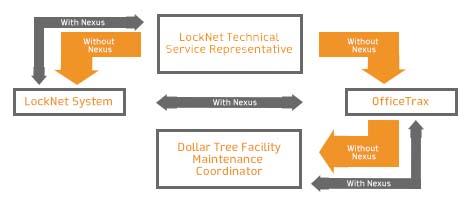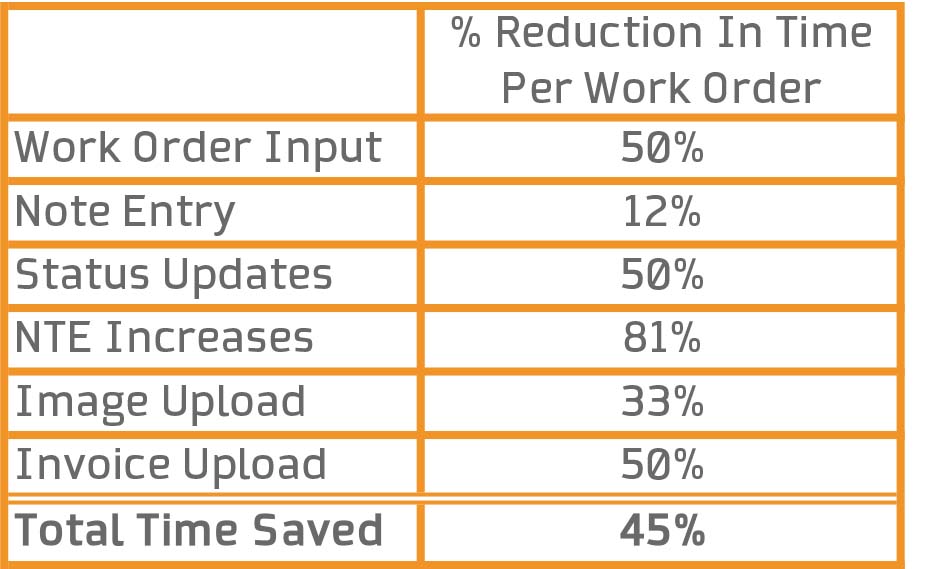Doing More With Less & Saving Money In The Process
Co-Authors: Maureen Lux with Dollar Tree & Mark Coughlan with Officetrax
Many organizations today are looking for ways to save time and money – to do more with less. We have more on our plates and less time to complete those tasks. Computerized Maintenance Management Systems (CMMS) entered the scene a few years ago with a powerful solution that allows customers and vendors to streamline communications and drastically increase efficiencies. These web-based systems centrally manage all work orders from call creation all the way through to invoicing. When used properly, CMMSs increase service levels and reduce the amount of time that the customer spends managing each individual vendor.
While highly beneficial, for vendors, working with CMMSs can pose a unique set of challenges such as: duplicate data entry, training on multiple systems and extra communication layers. This leads to increased time spent handling each work order, translating to increased costs and price increases to the end customer or reduced profit. This can also create frustrations for the customer due to incorrect and/or incomplete data. However, when vendors learn how to properly engage with these organizations, it increases efficiency and helps the vendor provide higher service levels to the customer.
What are Integrated Web Services?
 Dollar Tree, Officetrax and LockNet have partnered together to resolve the issues outlined above and increase efficiencies through the implementation of integrated web services. Integrated web services bridge the vendor’s system with the CMMS and allows for instant data communication. Officetrax developed Nexus, which has enabled LockNet and Dollar Tree to communicate with drastically increased efficiency. For example, it is critical for store managers to know when they can expect the vendor to be on-site. When LockNet enters that data in its system, the data bridge automatically updates Officetrax, and in turn, Dollar Tree with that information. If parts are needed and LockNet adjusts the on-site date, the data bridge will automatically change the status of the service call in Officetrax to indicate that parts are needed and will update the new on-site date. All that the store manager or facilities department needs to do to find out what is happening with a service call is to view the call in Officetrax, and they will see real-time data. They no longer have to pick up the phone or send an e-mail. Integrated web services provide both the vendor and the customer with a multitude of benefits, while presenting a minimal amount of challenges.
Dollar Tree, Officetrax and LockNet have partnered together to resolve the issues outlined above and increase efficiencies through the implementation of integrated web services. Integrated web services bridge the vendor’s system with the CMMS and allows for instant data communication. Officetrax developed Nexus, which has enabled LockNet and Dollar Tree to communicate with drastically increased efficiency. For example, it is critical for store managers to know when they can expect the vendor to be on-site. When LockNet enters that data in its system, the data bridge automatically updates Officetrax, and in turn, Dollar Tree with that information. If parts are needed and LockNet adjusts the on-site date, the data bridge will automatically change the status of the service call in Officetrax to indicate that parts are needed and will update the new on-site date. All that the store manager or facilities department needs to do to find out what is happening with a service call is to view the call in Officetrax, and they will see real-time data. They no longer have to pick up the phone or send an e-mail. Integrated web services provide both the vendor and the customer with a multitude of benefits, while presenting a minimal amount of challenges.
What are Vendor Benefits to Integrated Web Services?
For LockNet, the key benefits of integrated web services are:
1. Increased service levels to the customer
2. Improved efficiency
3. Reduced costs
 The data bridge has enabled LockNet to reduce the work order handling time by 45 percent per call. This is because tasks such as accepting the work order, providing detailed on-site updates, requesting information, submitting NTE increases, uploading images, and uploading invoices are now centrally managed from LockNet’s system without needing to manually log into Officetrax. Without Nexus, each task would have to be performed in the LockNet system, and then again in Officetrax. This elimination of duplicate data entry saves an immense amount of time, which translates to money saved. LockNet performed a time study to calculate the true time savings that integrated web services enabled. The results of this study are shown to the right. Due to the increased efficiencies, the data bridge has enabled LockNet to absorb the workload of an additional Technical Service Representative for every 5,600 work orders.
The data bridge has enabled LockNet to reduce the work order handling time by 45 percent per call. This is because tasks such as accepting the work order, providing detailed on-site updates, requesting information, submitting NTE increases, uploading images, and uploading invoices are now centrally managed from LockNet’s system without needing to manually log into Officetrax. Without Nexus, each task would have to be performed in the LockNet system, and then again in Officetrax. This elimination of duplicate data entry saves an immense amount of time, which translates to money saved. LockNet performed a time study to calculate the true time savings that integrated web services enabled. The results of this study are shown to the right. Due to the increased efficiencies, the data bridge has enabled LockNet to absorb the workload of an additional Technical Service Representative for every 5,600 work orders.
What are Customer Benefits to CMMS Integrated Web Services?
The efficiency improvements realized by the vendor lead to benefits for the customer as well. As a result of the data bridge, Dollar Tree has seen:
1. Improved service levels
2. A buffer to price increases
3. Improved internal reporting
Service levels are increased by improved response times, improved data accuracy and real-time updates. Store managers and the facilities department know the information just as soon as LockNet does, and no one has to worry about communication being dropped along the way. If Dollar Tree has any questions, they simply send LockNet a note through Officetrax. LockNet’s system automatically alerts them to the question, and they are able to send Dollar Tree an immediate response; all without ever manually logging into Officetrax.
Another benefit is a decreased need for a price increase because managing the account is less labor intensive. Being a single price point retailer, Dollar Tree is very cost conscious.Therefore, Nexus provides them the ability to keep both their cost as well as their vendors’ costs down. Nexus has also enabled Dollar Tree to have more accurate reporting on their spending by trade and problem type. LockNet codes each work order with a problem code, and Nexus transfers this information automatically to Dollar Tree’s system, enabling them to have a more accurate view of where they are spending their repair dollars.
What are the Challenges?
While there are many valuable benefits, implementing and managing integrated web services presents challenges for the vendor. There needs to be a commitment to:
1. Startup costs and development
2. Monthly maintenance fees
3. Ongoing testing and support
The initial implementation can be expensive. Many CMMSs charge a fee to implement the data bridge. In addition, the vendor must incur the cost to develop the data bridge, which takes a minimum of 50 man hours if handled in-house. If the vendor does not have their own in-house software system, their software vendor must get involved in the data bridge development. After the bridge is created, testing must be performed on the customer and vendor side to ensure that all data is transferring properly. To make the testing and transition easier and faster, Dollar Tree chose to roll out Nexus in a modular approach. There are many different operations that Nexus supports, and they can be turned on/off independently of one another. For example, Dollar Tree and LockNet rolled out the data bridge for work order notes and invoice submittal prior to rolling out the data bridge for RFPs. While this approach is faster and easier to implement, it means that each time a new operation is bridged, additional testing must be performed. In addition to testing costs, there are recurring fees for access to the web services as well as costs of monitoring and support of the data bridge that must be incurred and performed by the vendor.
Despite these costs, vendors will see a fast return on their investment, particularly if they process a high volume of calls through the CMMS. The benefits are powerful and well worth the investment. Integrated web services allow the customer to experience increased service levels and enables the vendor to reduce call handling costs. In the age where companies are trying to do more with less, Computerized Maintenance Management Systems coupled with integrated web services help organizations achieve much higher levels of efficiency and communication than was previously possible.
*This article originally appeared in PRSM Magazine.
